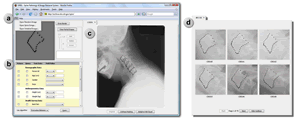CEB Projects |
|
Project Member(s): Sameer Antani, Rodney Long, Leif Neve
 With the increasing use of medical images in clinical medicine, disease research, and education, the need for methods that effectively archive, query,
and retrieve these images by their content is underscored. An implementation of such a prototype Web-based Content-Based Image Retrieval (CBIR) system
called SPIRS (Spine Pathology & Image Retrieval System) demonstrates recent developments in shape representation and retrieval from a large data-set
of 17,000 digitized x-ray images of the spine and associated text records from the Second National Health and Nutrition Examination Surveys (NHANES II).
Rather than limiting queries to textual keywords or relations (as available in WebMIRS, for example), CBIR enables users to provide a query sketch/image,
which is then used to find similar images of the same modality, anatomical region, and disease along with the associated text records.
With the increasing use of medical images in clinical medicine, disease research, and education, the need for methods that effectively archive, query,
and retrieve these images by their content is underscored. An implementation of such a prototype Web-based Content-Based Image Retrieval (CBIR) system
called SPIRS (Spine Pathology & Image Retrieval System) demonstrates recent developments in shape representation and retrieval from a large data-set
of 17,000 digitized x-ray images of the spine and associated text records from the Second National Health and Nutrition Examination Surveys (NHANES II).
Rather than limiting queries to textual keywords or relations (as available in WebMIRS, for example), CBIR enables users to provide a query sketch/image,
which is then used to find similar images of the same modality, anatomical region, and disease along with the associated text records.
The goal of this work is to develop a retrieval system that implements recent developments in shape representation, efficient indexing, and similarity matching; supports whole and partial shape matching, which enables a wide range of meaningful queries to be posed; and utilizes a distributed frame-work, which is customizable to the needs and constraints of healthcare environments. SPIRS provides a Web-based inter-face for performing image retrieval on a database of digitized spine x-rays using the morphological shape of the vertebral body. A query editor enables users to pose queries by sketching a unique shape or selecting or modifying an existing shape from the database. Additional text fields enable users to supplement visual queries with other relevant data (e.g., anthropometric data, quantitative imaging parameters, patient demo-graphics). These hybrid text-image queries may be annotated with pertinent pathologies by selecting and weighting local features to indicate importance. Query results appear in a customizable window that displays the top matching results and related patient data. SPIRS provides a working proof-of-concept that demonstrate the capability of accommodating large amounts of imaging data expected in the near future.
The figure shows a screen capture of the SPIRS client applet (left) and a cropped screen capture of the overall results view tab shown in (d). The default view consists of: (a) the query menu, (b) query editor; and (c) overall view
Click here to access the tool.









